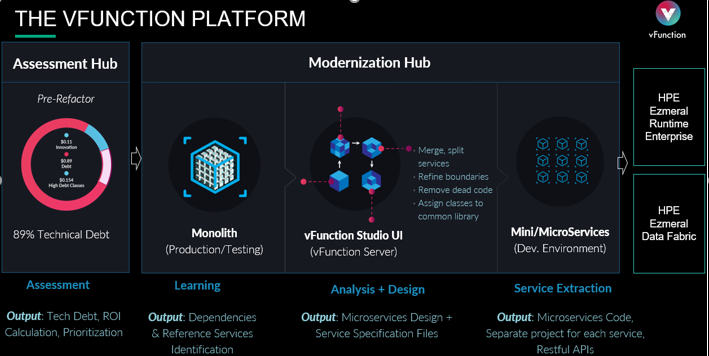Co-authored by Amir Rapson at vFunction and Ka Wai Leung at HPE
Enterprises have developed many Java applications over time, with many of these applications being deployed as mission critical workloads. These Java applications are mainly monolithic applications with a single tightly coupled large code base that is tied to a technology stack. Managing and releasing these types of applications are challenging for development teams.
Making small changes might have a rippling effect on the whole code base, as everything is tightly coupled. Scaling these applications is not easy as you must scale the whole monolithic application versus a single module. These application limitations make it difficult for enterprises to rapidly adapt to new business and customer requirements.
Solving the problem with vFunction
HPE is excited to partner with vFunction to offer an end-to-end solution for Java application modernization. vFunction is also a member of the HPE Pathfinder program, which identifies and invests in category-leading start-up companies. vFunction offers a unique value proposition for developers and architects to transform intelligently and automatically complex, monolithic, Java applications into microservices, restoring engineering velocity and making these applications cloud ready.
vFunction incorporates AI into its product to automatically analyze monolithic codebases, both statically and dynamically during application runtime (in production or pre-production). The vFunction Platform consists of two modules: vFunction Assessment Hub and vFunction Modernization Hub.
The vFunction Assessment Hub calculates the technical debt of your monoliths, providing a lightweight assessment of the migration effort to build a business case with ROI figures for modernization. Once an application is selected for modernization, on the same platform, the vFunction Modernization Hub continues with deeper analysis of the application by observing business flows and tracking application behavior and dependencies to discover and present the true logical domains inside the monolith. Architects can now iteratively design and deploy improvements to the architecture as well as automatically extract fully functioning microservice code with RESTful APIs ready for deployment.
Figure 1 – the vFunction platform on HPE Ezmeral
The HPE and vFunction Joint Solution
Application modernization typically involves manually refactoring existing Java or .NET code segments into microservices while trying to preserve the application’s original functionalities as much as possible. This process is complex, time consuming, and risky, but HPE’s joint solution with vFunction reduces risk, accelerates modernization, and brings immediate ROI. An end-to-end solution, it contains a mix of product and services that assists the customer from discovery, architecture, migration, deployment, and maintenance.
- HPE Cloud Native Engineering Services assists customers throughout the whole migration cycle. These include the discovery of suitable applications, analysis of those codes, extraction of codes to microservice based applications, and onboarding of those services for customers who don’t have application modernization experience or expertise.
- HPE cloud optimized solutions include HPE GreenLake for Private Cloud Enterprise and HPE Ezmeral to provide the underlying platforms for hosting the modernized applications.
- Customers can deploy their modernized applications using their own infrastructure or let HPE manage such infrastructure through HPE GreenLake as a service.
Figure 2: HPE and vFunction joint solution HPE Ezmeral
Customers can implement their modernized application on bare metal, VM, or containers. For those choosing a container approach, they can leverage HPE Ezmeral Runtime Enterprise, a Kubernetes platform for hosting and orchestrating their containerized microservices. HPE Ezmeral Runtime Enterprise is a container orchestration management control plane that allows users to easily organize compute and storage resources located anywhere and quickly create and deploy Kubernetes clusters on those resources. Multiple versions of Kubernetes can be running at the same time under HPE Ezmeral Runtime Enterprise management.
HPE Ezmeral Runtime Enterprise is an ideal Kubernetes platform for hosting modernized application because it has the following:
- A single pane of glass management and visibility across Kubernetes clusters both on prem and off prem
- Enterprise-grade security and built-in security controls to integrate with identity providers such as AD/LDAP; single sign-on, SAML integration; role-based access controls for secure access to the platform; and Falco container runtime security for proactive threat detection and alerting
- GitOps-based centralized policy management, drift management, and fleet management of clusters. It uses Argo CD to ensure clusters are consistent and immutable for continuous compliance.
HPE supports a flexible deployment of these modernized applications either on premise or via a multi-cloud environment. HPE Ezmeral Runtime Enterprise can run on premises within an IT datacenter or on public clouds. For customers who want to optimize their IT resources and infrastructure, they can deploy these applications on HPE’s GreenLake Container-as-a-Service (CaaS). HPE GreenLake offers a fully managed, scalable IT consumption model where organizations only pay for capacity used. HPE can deliver a preconfigured CaaS solution designed for multi-cluster, multitenant Kubernetes deployment directly to your on-premises or co-located data center using HPE’s Private Cloud for Enterprise.
HPE Discover 2022 included various sessions on cloud-native technologies. Keep an eye on the HPE Discover More Network where we’ll be posting on-demand videos of these sessions.
Learn more about HPE technology consulting services, HPE GreenLake, and HPE Ezmeral, and how the HPE Ezmeral ecosystem can help customers take their digital transformation to the next level for their different workloads.
About the authors:
Amir Rapson
Amir Rapson co-founded vFunction and serves as its CTO, where he leads its technology, product, and engineering. Prior to founding vFunction in 2017, Amir was a GM and the VP R&D of WatchDox until its acquisition by Blackberry, where Amir served as a VP of R&D. Prior to WatchDox, Amir held R&D positions at CTERA Networks and at SofaWare (Acquired by Check Point). Amir has an MBA from the IDC Herzlia, and a BSc in Physics from Tel-Aviv University.






